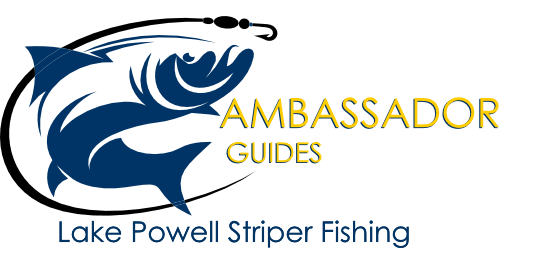Lake Elevation: 3574
Water Temperature 54-62 F
Lake Powell water level increased a fraction of
an inch this week. It wasn’t much but it is a step in the right
direction. Combine that with warming temperatures and increasing day
length and the ingredients are in place for good fishing. Now the final
ingredient is to plan your trip when weather is warm and calm. Try to avoid a
cold front with wind if possible. Warming water may even overpower the
full moon effect which will be encountered this week. (If I had to choose between
this week and next I would go later due to full moon).
All of the sport fish species are starting to move up in the water column
seeking to find the warm surface layers. Smallmouth bass finally found a
few days when the morning water temperature was above 57 degrees which is their
trigger for increased activity. Bass action is not strong yet but more fish
were caught this week than last and many more will be caught the last two weeks
of April. Plastic grubs and tubes on jigheads worked slowly along the
bottom are effective now along with drop shot rigs and shad shaped worms.
For those that like to fish faster, try a spinnerbait worked methodically along
the shoreline with a fast retrieve so all the likely habitat is tested.
Square bill crankbaits are also a good choice for covering a shoreline in a
hurry.
Walleye fishing will get better each week from now until the end of May. Fish
muddy water in the afternoons with a plastic grub tipped with a live night
crawler. Walleye have a distinctive bite that duplicates the feel of a
rubber band. Walleye grab the tail of a plastic grub and then pull on it
slightly before letting go allowing the grub to shoot forward. When this
happens immediately drop the lure to the bottom instead of reeling in. The
walleye will come over and take another look. It usually takes two or
three pickups before a walleye is hooked. If the walleye tastes the live worm
it is much more likely to be caught.
Stripers are the most active fish right now. Schools are running from the main
channel walls to the backs of the canyons. Main channel fish are located in
very deep water that is closely associated with a shallow shelf. At the dam the
best fishing spots are found where a shelf extends out 20-30 feet from the
cliff wall. At this lake level there is a nice shelf under the chain link fence
that sticks out on the west side of the forebay about 100 yards from the
barricade.
In Navajo, Labyrinth, and the Buoy 25 cove striper schools hover at the
breaking edge of the 30 foot shelf where they can quickly descend to deep water
when danger threatens. Anchovy chum will keep the school around long
enough to catch quite a few or possible draw them back up once they have moved
to deep water. I find that schools repeatedly return to the same spots.
If they quit give them a rest and then come back later for a rerun.
The other option is to head to the back of the canyon and troll and cast in
murky water where bottom depth varies between 15-45 feet. Troll lures
with a white background marked with a chartreuse stripe. This color
combination has been deadly so far this spring. Shad raps, X-raps, and
Norman Little Ns are flat-line trolling very well. As the day warms
stripers move shallower and can be caught right up against the shallow flats
now seen in the back of many canyons. Shad have moved on to the flats and
stripers wait for them to swim back into deeper water. Look for grebes to mark
shad schools. Stripers can’t resist chartreuse and white jerk baits that swim
out of shallow water into their feeding zone. Most of the stripers are
eating plankton but they all signed a pledge at birth that they would eat any
forage fish that invaded their personal space. Put a lure in front of their
face and they will definitely bite the fish first and look for more plankton
later.
This report is heavy on southern lake experience but midlake and north lake
fish will respond in a similar manner. These techniques will work just as
well in the San Juan, Escalante and Good Hope Bay.



